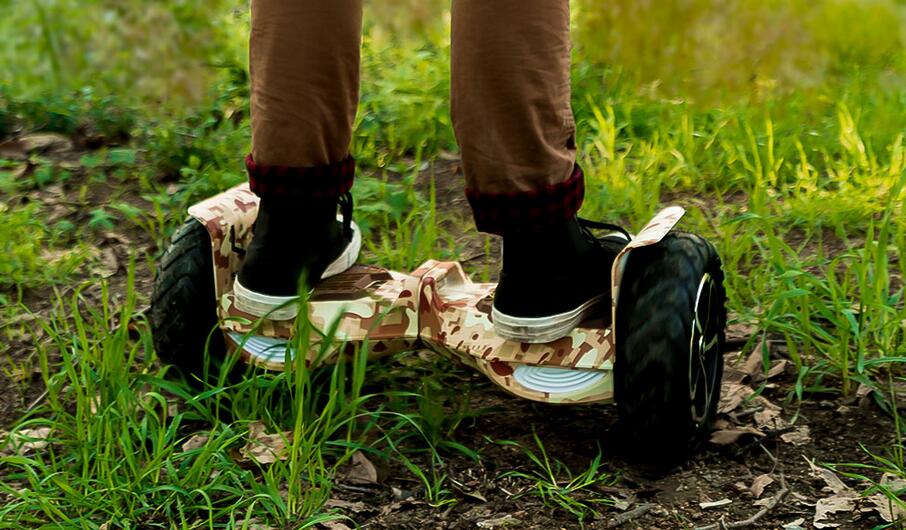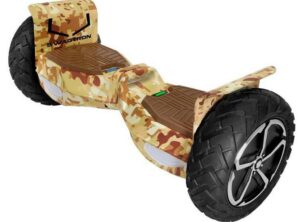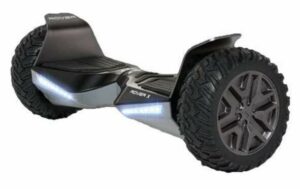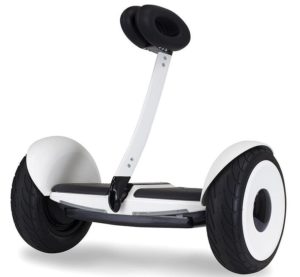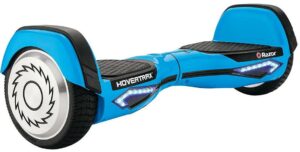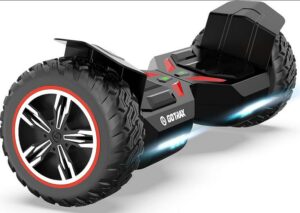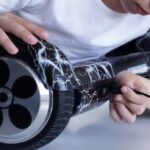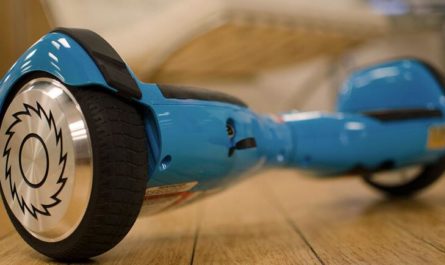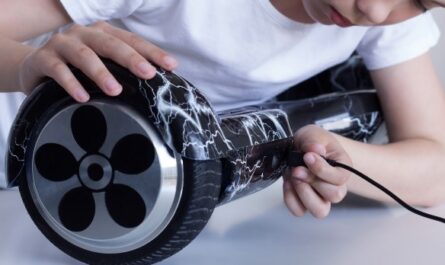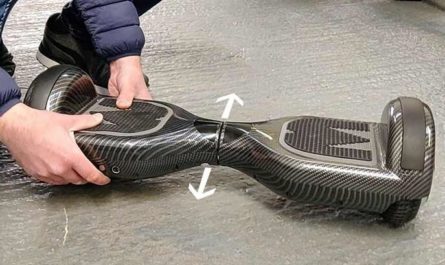Hoverboards are also known as self-balancing scooters or electric rideables. They consist of two motorized wheels connected to a platform that can respond to the rider’s movements. Hoverboards are Initially designed for riding on flat, smooth surfaces like roads and sidewalks.However, the technology has rapidly evolved. Now there are rugged, all-terrain models built specifically for off-road adventures. But can you safely ride a hoverboard on grass, gravel, dirt trails and carpets? What about wet or uneven terrain?
This complete guide will cover everything you need to know about taking your hoverboard off-road. We’ll discuss the critical factors to consider, review top models for all-terrain use, and provide essential safety tips for outdoor riding.
Table of Contents
Are Standard Hoverboards Meant for Outdoor Use?
The original hoverboards that debuted in 2015 were optimized for short urban commutes and indoor hovering. They had smaller 6.5” wheels and simple tread designs aimed at flat concrete and pavement.
Riding anywhere other than a smooth sidewalk or driveway could be risky and damage the hoverboard. Their motors and builds were just not rugged enough for off-roading.
However, the technology advanced rapidly. Companies soon began designing more powerful hoverboards with larger air-filled tires, grippy treads, and reinforced waterproof bodies perfect for all-terrain adventuring.
These off-road models opened up a whole new world of hoverboarding beyond the suburbs and through fields, forests, beaches and wherever your imagination takes you!
Some key benefits of all-terrain hoverboards include:
- Exploring nature and off-road trails not accessible on standard models
- Handling bumpy, uneven ground with greater stability
- Providing an exciting riding experience away from vehicles and traffic
- Ability to ride over grass, gravel, dirt, sand and mud
- Showcasing your skills by maneuvering obstacles and varied terrain
Now that specialized models exist for going off-road, let’s look at what exactly you should consider before hitting those trails.
Critical Factors for Off-Road Hoverboard Riding
Depending on the model, some will perform better on grass, gravel and natural terrain. Others will struggle and potentially break down. Consider these key factors when determining which hoverboard is right for your needs:
1. Wheel Size
Standard hoverboard wheel sizes range from 6.5” to 10”. For riding off-road, bigger is better!
- 6.5” wheels – Only suitable for completely flat indoor and urban settings. Too small for unpaved surfaces.
- 8” wheels – An improvement that can handle some grass and gravel, but still limited.
- 8.5”+ wheels – The recommended minimum for all-terrain hoverboards. Provides greater stability across uneven terrain thanks to increased ground clearance.
- 10”+ wheels – The gold standard preferred by off-road enthusiasts. Capable of rolling over large objects with ease. The best for riding off-road.
2. Tire Tread and Material
Hoverboard tires come in either solid rubber or air-filled models. Air-filled tires with deep tread patterns provide optimal traction on loose dirt, mud, grass and gravel.
Key tire features to look for include:
- All-terrain, deep lug tread – Grips uneven terrain and allows control on slopes
- Tubeless – Prevents flats and loss of pressure over time
- Puncture proof – Protects against sharp rocks and debris when riding over rough ground
- Large surface area – More points of contact with the ground enhances stability
Avoid hoverboards with small, slick solid rubber tires without deep treads. They’re only suitable for pavement and indoor floors.
3. Motor Power
More powerful motors improve an off-road hoverboard’s ability to handle slopes, uneven ground, and provide strong acceleration when needed. Look for dual motors with at least 300W – 400W or above.
This level of power allows you to maintain momentum over obstacles like large rocks or logs which would stop lesser hoverboards in their tracks. Stronger motors also give you the torque necessary for steep inclines.
4. Weight Capacity and Build
Larger riders will want a sturdier constructed hoverboard rated to handle their weight. All-terrain models designed for adults have a minimum capacity around 220 lbs, with some exceeding 420 lbs.
A durable build featuring reinforced plastic or aluminum prevents damage from drops, scrapes and debris strikes. Waterproof boards with high IP ratings allow riding through puddles and mud with no issues.
One-piece cast hoverboard bodies are the toughest, resisting both shocks and flexing. Cheaper hoverboards just screw together and can work loose over time when riding over rough terrain.
5. Rider Skill Level
Hoverboarding off-road is more challenging than casually cruising down a sidewalk. You’ll need to account for shifting terrain under the board, maneuver around obstacles, and maintain balance over bumps.
Until you get comfortable, beginners should avoid risky speeds or slopes. Learn fundamental hoverboarding skills like accelerating, turning and stopping on simpler surfaces first before attempting advanced all-terrain riding.
How Hoverboards Perform on Specific Surfaces
Hoverboard capabilities vary widely depending on the model and its suitability to certain types of terrain. Let’s break down how common surfaces like grass, gravel, dirt and carpet impact performance:
1. Grass
Short, dry grass is manageable for basic hoverboard models with 6.5″ – 8″ wheels. But tread patterns not optimized for dirt have difficulty finding traction, so acceleration and braking distances are increased.
Once grass grows thicker and higher, only larger all-terrain hoverboards can cut through effectively. Standard models will get bogged down and struggle to move.
Moist grass poses the biggest challenge. Wet grass can damage motors and electronics if it gets flung onto the internal components. Only ride over damp grass with hoverboards featuring high waterproof IP ratings.
2. Gravel
Small loose gravel is rideable by rugged all-terrain hoverboards. But larger and sharper rocks can damage tires, wheels, and axles over time. It’s recommended to avoid large gravel whenever possible.
Riding over gravel increases risks of skidding or losing stability if you turn sharply. Gravel trails reduce traction compared to hard dirt paths. Slow your speed and allow greater braking room to compensate.
Gravel also poses problems for non-sealed hoverboards without high IP dust protection ratings. Tiny pebbles and debris can get sucked into motors and electronics, potentially causing failure down the line.
3. Dirt Trails
Packed dirt paths and off-road trails present fewer challenges than grass or gravel. Even standard 6.5″ wheeled hoverboards can often handle groomed dirt conditions.
But once the trail gets very bumpy, rocky, has big ruts, or steep inclines, you need an all-terrain hoverboard. Lesser models struggle with maintaining momentum and stability under those conditions.
The biggest risks on dirt trails are hidden obstacles like rocks, branches, holes that can stop a hoverboard in its tracks or cause loss of control. Keep speed in check and stay alert.
Muddy terrain makes dirt trails exponentially harder to traverse. Avoid deep mud which can get flung onto the hoverboard’s internal components.
4. Carpet
Thin, low pile carpets are generally manageable for hoverboards to ride over slowly. But traction is still reduced, so acceleration and turning is hampered.
Thick carpets should be avoided entirely. Wheels can catch and cause crashes. At best, hoverboards slowly creep along with severely diminished performance.
Additionally, hoverboard tires can snag carpet fibers as they spin, progressively damaging the carpet over time. Unless you don’t care about potential destruction, carpets are not recommended as a riding surface.

